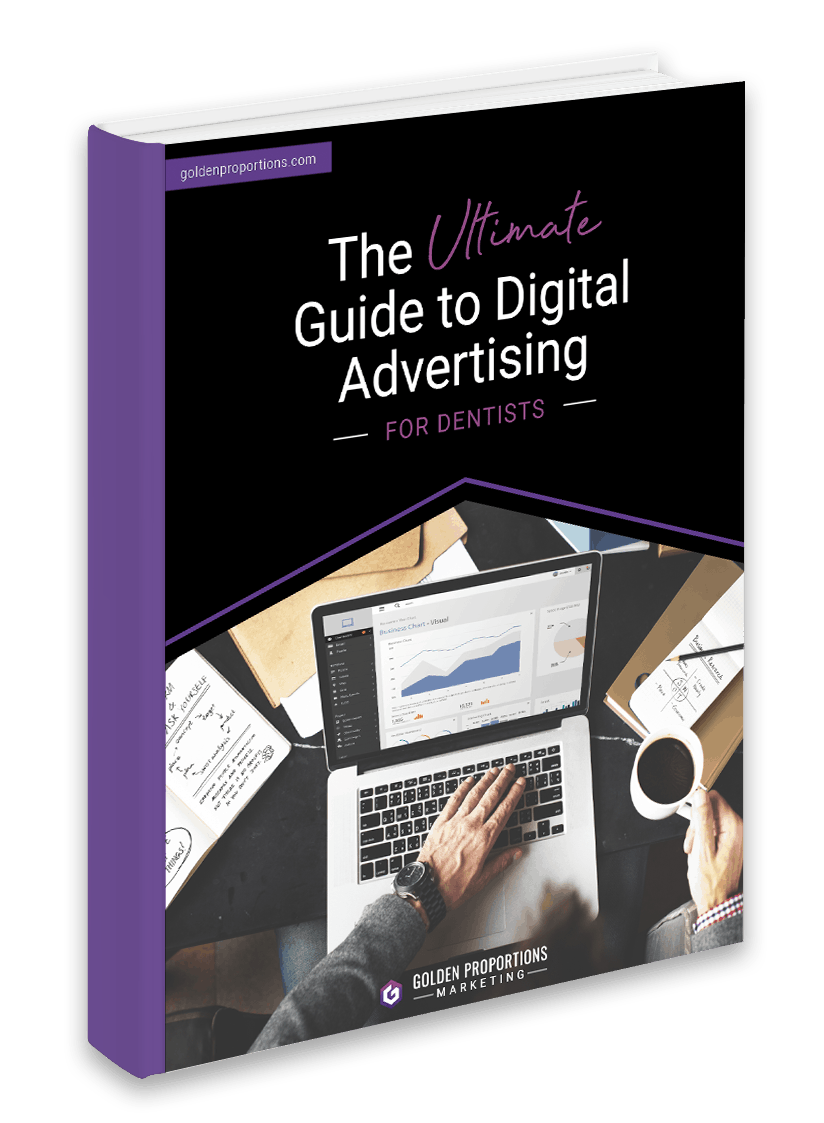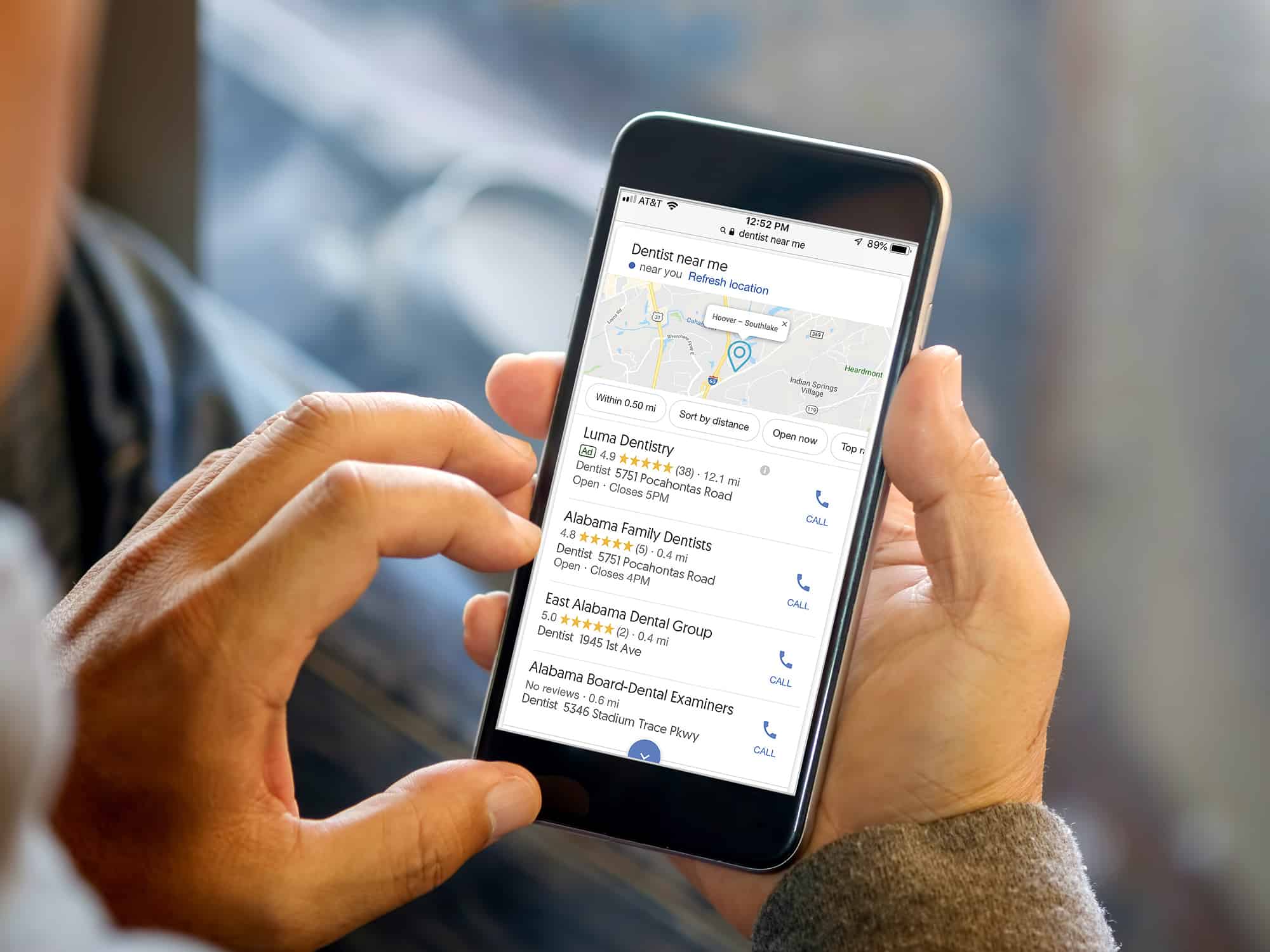Get the attention you deserve
Remember the days when “advertising” for your dental practice meant securing a small corner space in the local newspaper? Or maybe even the Yellow Pages?
Those days are not completely gone, but they have definitely been surpassed by the world of digital advertising. Digital ads have revolutionized marketing, offering features and benefits that help dentists get greater value and better results from their marketing budget.
For most dental practices, managing a digital advertising campaign is a challenging task, and the majority of offices will opt to work with a digital marketing agency to handle it effectively. But that doesn’t mean you can’t (or shouldn’t) gain a deeper understanding of digital advertising to make sure you’re getting your money’s worth. Whether you’re new to digital marketing, or just want to get a better understanding of how it all works, then The Ultimate Guide to Digital Advertising for Dentists is just what you need so you and your marketing agency will be on the same page.
Why should dentists use digital marketing?
The advantages of digital marketing for dentists really come down to three elements that traditional advertising never even came close to offering, even in their heyday.
Targeting
If you were placing a newspaper ad, the closest you could come to targeting your dental advertising for a particular audience was choosing between the Sports or Home and Garden sections.
Digital ads, on the other hand, offer an amazing range of possibilities for focusing on your ideal patient persona. Demographic data like location, age, gender, family size, income, home value, employment status and more are all available to choose from. On top of that, certain platforms allow you to zero in based on interests and online behavior. So if you decide that your “perfect” patient is a working mom in her mid-thirties who lives in a middle-class neighborhood and enjoys cooking… you’ll find her.
Timing
If you don’t like waiting, then you’ll love digital marketing for dentists. The amount of time it takes to launch a dental ppc ad for your practice is only limited by how long it takes to create it. No more waiting for the next edition of the paper to hit the newstand tomorrow (or next week). You can also schedule ads to run certain days of the week, or even certain hours of the day, based on when you think your ideal patient will most likely be online to see it.
Tracking
Knowing exactly how well your dental internet marketing is performing is empowering. Occasionally hearing patients mention that they saw your ad was once gratifying enough to convince you that your marketing was working. Today, however, data is everything. With proper reporting, you’ll know which ads are working best and whether you are spending too much or too little to reach your marketing goals.
Types of digital ads dentists can use
With so many options to choose from, deciding exactly what type of digital marketing for dentists to use can seem overwhelming. It helps to know what you’re trying to accomplish and whether you’re trying to reach an active or passive audience. In other words, do you want to find new patients, or do you want new patients to find you?
Search ads: when you want patients to find you
If patients are online actively searching for dentists in your area or information on dental treatment, you know they are probably motivated to take action. That’s good news for you. If you can anticipate what they will be looking for on Google or other search engines, you can use search ads to capture them as leads or convert them to new patients.
Dental ppc ads certainly aren’t fancy. In fact, they’re just plain old text. Their real value lies in their location. When users search online, they rarely go beyond the first page of search results. And that’s exactly where paid search ads can position you. You may be thinking “can’t we just get on the first page with good search engine optimization (SEO)?” Sure, but it takes time. And effort. And maybe even some luck. Paid ads can be a guaranteed way to get yourself on top of page one.
Dig Deeper
Dental Google Maps Marketing: Google Ads Can Help You to Dominate!
If you’re a dentist who wants more patients (and who doesn’t?) you know you have to get your dental website […]
Display ads: when you want to find patients
For the more passive audience that isn’t actively searching for dental care, you can still get their attention and steer them toward considering your dental practice by using display ads. Display ads are also a great choice for dental advertising ideas that benefit from a strong visual element, like cosmetic dentistry before/after photos or video content.
There are an endless number of digital advertising platforms to choose from, but to optimize your advertising budget you want to focus on the most effective ones. For dentists, those are the Google display network and Facebook (including its sister platform, Instagram).
You already know that Google is your best bet for search ads, but it also reaches 90 percent of all internet users worldwide through its display ads network of millions of websites, news pages, blogs, and Google sites like Gmail and YouTube. Facebook also reaches an impressive number of people, with 69 percent of U.S. adults actively using the social media platform.Tack on the 37% that Instagram reaches, and you have quite an audience.
On a side note, you may have heard of Boosted Posts on Facebook. While these are an effective way of expanding the reach of your social media, they are a bit different from true Facebook display ads.
Dig Deeper
Use the Right Kind of Dental Internet Marketing to Attract New Dental Patients
If you’re using dental internet marketing, you know that getting the best ROI depends on reaching the right people in […]
Keys to creating effective digital ads
Can a novice create a digital ad? Yes.
Can a novice create an effective digital ad? Probably not.
Whether you’re doing your own ads or using a dental advertising agency, search ads and display ads need to be fully optimized to get the best possible results for online marketing for dentists.
Keys to a successful search ad
Planning: choosing the right keywords
Finding the right keywords to target is the biggest challenge for creating successful dental ppc. Being too broad or off-topic in your keyword selection will bring in people you aren’t really targeting. Any mismatch between your keywords and your advertising message will waste clicks on people who will just be disappointed that your ad didn’t give them what they were really looking for.
Competition for more popular keyword searches can drive up your budget in a hurry. Don’t feel that you need to go for the keywords with the highest search volume. Investing your money in more specific, “long-tail” keywords can actually yield better results and provide you with better qualified leads and increase your return on investment (ROI).
Negative keyword targeting is also an effective way to exclude your ad from irrelevant searches. For example, you may want your ad to appear for “cosmetic dentistry” but probably not for “cheap cosmetic dentistry.” In that case, using a negative keyword list that hides your ad from searches that include “cheap” and other similar undesirable terms can produce better results.
Creative: nailing the headline and ad copy
With a limit of 30 characters for your headline and 90 characters for your description, you really need to choose your words carefully. Your headline has to grab attention and resonate with what your target audience is searching for. Then, your description should provide a compelling reason for clicking through to your website or landing page.
Since you have a limited number of characters to work with, including Extensions with your ad description is also a great idea. Extensions are additional information or links included with your search ad that can greatly increase your conversion rates. Some of the most useful types of extensions for dental ads are:
Site Link: links to specific pages on your website
Location: clickable address for your business
Call: clickable phone number (for mobile ads)
Structured Snippet: similar to Site Link extensions, but with headlines and descriptions for the page that is linked to
Rank: optimizing your quality score
If you’re wondering why your competitors’ search ads are ranking higher than yours, don’t assume it’s only a result of how much money you spend. In addition to your advertising budget, the rank of your search ad is determined by your Quality Score. That score, calculated by Google, is a measure of how relevant your ad, keywords, and landing page are to your audience. The more relevant your ad is, the higher it can rank for the same dollar amount.
There are several factors that Google looks at to determine your Quality Score that are not directly under your control, but if you can optimize your keywords, ad, and landing page in terms of quality and how well they are targeted for your audience, you’ll greatly improve your chances of moving up above your competition.
Keys to a successful display ad
Targeting
Targeting tools vary somewhat across the major digital ad platforms, but they all essentially take a combination of three approaches to helping you reach the right audience.
Demographic targeting: who are they?
This type of targeting uses demographic data, such as age, gender, education level, income, marital status, and occupation.
Psychographic targeting: what are they interested in?
Psychographic targeting filters audiences based on their activities, interests, opinions, values, personality traits, or lifestyle choices. Among other indicators, their interests could be determined by websites they’ve visited or Facebook pages they have interacted with.
Behavioral targeting: what have they done?
Behavioral targeting looks at what actions people have taken online, including website visits, ads clicked, and purchases made. Retargeting, which tracks people who have previously visited your website or landing pages, is an especially useful type of audience to target if you want to reach people who already have shown interest in your dental practice.
Topic
With your audience determined, next you need to connect with them by focusing your ad on the topic that will appeal to them most. If you have personas developed for your ideal patients and you know where they are in their journey toward becoming a new patient, you’ll know what their needs, challenges, and goals are. That will help you decide the benefits and offers you can provide that will convince them to interact with your ad.
Creative considerations
Display ads need to be attention-grabbing to be effective, since you are essentially “interrupting” your audience while they are online for something else. They also need to give your reader a reason to click through. That means a lot of thought will go into how your ad looks and what it says.
Design
If your ad doesn’t look professional, it can reflect negatively on your dental practice. A good design will also stop your audience in its tracks and draw them into the ad, looking to find what kind of value you are offering. Typography, color, and visual elements like photos and video are all things that a dental advertising agency will have an expert knowledge of, and they will know what design decisions will lead to a better conversion rate for your ad.
Copy
Just like with search ads, your headline and description are important and will determine whether or not you get your audience to click through. Headlines need to make people want to read more, and descriptions and call-to-action (CTAS) need to drive people to take the next step. Skilled copywriters know how to trigger those responses.
Dig Deeper
6 Tips to Create Great Instagram Ads for Dentists
Instagram ads for dentists…sounds like a good idea, right? If you’ve been working to build your profile on this valuable […]
How digital marketing funnels convert leads into dental patients
Your online ads are just one part of the overall digital marketing for dentists funnel that leads new patients into your office. After attracting people with your ads, the goal is to convert them to leads, close the sale to convert them to patients, and then delight them so they keep coming back.
Attract them with digital ads
The main purpose of your dental ppc ads is to capture attention and inspire action to take the next step. That next step isn’t always scheduling an appointment. (Although, in the days of print ads that typically was the case.) Getting them to fill out a form on a landing page to download some valuable information can be much easier than asking them to pick up a phone and call your office.
Convert them to leads with a landing page
A landing page is simply a web page that is designed to get visitors to take a specific action. Your digital ads will lead the horses to water, but it’s up to your landing pages to get them to drink. To do that, landing pages must do a few important things.
Keep visitors focused
When a visitor arrives on your landing page, you want them to do one thing and one thing only. You don’t want any distractions that will lead them away or make them forget why they clicked through in the first place. Everything on the page should work together to lead them to the action you want them to take.
A good landing page design:
- WILL have captivating visuals
- WILL NOT have navigation menus that lead to your website pages
- WILL clearly state benefits of the offer
- WILL NOT be overly wordy
- WILL have a simple form that doesn’t ask for too much information
One common mistake dentists make is to send ad traffic to their home page instead of a landing page. Unless your goal is to specifically increase your website traffic, most of your visitors will leave your site without taking action, wasting your ad budget.
Give them what they want
To get people to click on your ad and visit your landing page, you need to offer something they want or need. And that offer should be appropriate for the stage in the patient journey you are targeting with your online marketing for dentists.
The awareness stage describes people who are just discovering you and your dental practice for the first time. They may also be trying to determine if they need to seek dental care. Since this is your opportunity to make a first impression, you might want to offer a helpful guide or other type of download that they will find useful and that will showcase your expertise.
People in the consideration stage are learning more about you and the dental care they may need. Offering a download that educates them about a particular dental procedure they are considering or about the services you offer will be exactly what they are looking for.
If you are advertising to people in the decision stage, they are looking for reasons why they should (or shouldn’t) visit your dental office. Offer something that might sway them (like a money-saving discount or a link for convenient online appointment scheduling).
Convince them they’re making the right decision
Sometimes people need a little reassurance to complete an action on your landing page. That’s where testimonials come in. When your landing page visitors can see “social proof” in the form of positive comments about your practice from other patients just like them, it helps reduce their hesitation to hit the submit button.
Close the deal with marketing automation
If your landing page call-to-action (CTA) is a download, or anything else they would need to submit a form for, you want to capture their contact information, especially their email address. Once you have that, you can use automated email campaigns (called “drip” campaigns) to nurture your leads forward through their journey toward scheduling an appointment, continuing to provide them with the information that is appropriate for the stage they are in and pulling them into the next stage.
Delight your new patients with customer service
If your dental internet marketing funnel was successful and you landed a new patient, the rest is up to you to knock their socks off and keep them coming back. If you want some great advice on creating an amazing first impression, check out The Ultimate Guide to Improving the New Dental Patient Experience.
Dig Deeper
Building Your Dental Marketing Plan: Focus on the Patient Journey
Write a marketing plan? Ugh! Dental marketing plans can seem overwhelming to tackle. They’re long. And complicated. And time consuming. […]
Digital marketing glossary
Your digital marketing agency may use a lot of unfamiliar lingo when discussing your ads. To help you speak the language, the following is a short glossary of some of the most common terms that may come up in conversation.
A/B Test
A comparison between two options for an ad to determine which is more effective. Typically used to evaluate headlines, images, colors, and other creative elements.
Call to Action (CTA)
The action that you want a person to take on an ad or landing page.
Clicks
The number of times a link in your ad gets clicked.
Click Through Rate (CTR)
The number of Clicks divided by the number of Impressions, expressed as a percentage. This is a key indicator of the ad’s efficiency.
Conversions
The number of people who completed the intended action for an ad, such as downloading an offer. This number is typically lower than the number of Clicks.
Cost Per Lead (CPL)
The amount spent on ads divided by the number of new leads generated.
Cost Per Thousand (CPM)
Advertising cost structure where advertisers are billed per 1,000 impressions.
Engagement Rate
Typically used when evaluating social ads, the percentage of people who interact with an ad by clicking, commenting, sharing, or liking.
Impressions
The number of times your ad is displayed. Impression numbers can be higher than Reach totals since a person can be shown the ad more than once.
Reach
The number of people who have seen your ad.
Return on Investment (ROI)
The cost effectiveness of an ad, calculated by subtracting the cost of an ad from the revenue generated and dividing that difference by the ad cost.
Finding the right digital advertising agency
Hopefully this guide has given you a good overview of online marketing for dentists. The only thing left is to find a good dental internet marketing agency to work with. Here is a checklist of things you should consider when selecting a vendor you can trust to deliver results.
Marketing expertise
Obviously, any marketing agency you choose should have a deep understanding of internet dental marketing techniques and marketing strategy.
Attention to detail
Make sure your agency asks you questions. A LOT of questions. That’s the only way they’ll truly get to know you, your practice, your needs, and your goals.
Dental experience
We don’t have to tell you that dentistry is a very unique industry and dental patients are a very unique audience to market to. You may find the “right” digital marketing agency without dental experience, but expect it to take some time for them to get up to speed.
Proven success
Remember to check for reviews, read testimonials, and ask for case studies from previous clients. You don’t want to be anyone’s guinea pig while they’re figuring out how to do digital marketing for dentists effectively.
We're here to help
Of course, Golden Proportions Marketing checks all the boxes above, and we’re more than happy to help you with your digital marketing needs. Contact us whenever you’re ready to get started with your next advertising campaign!





